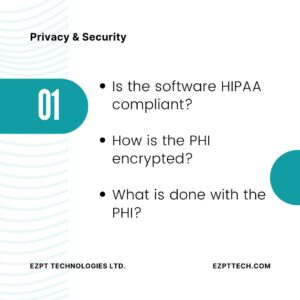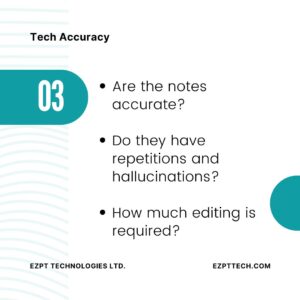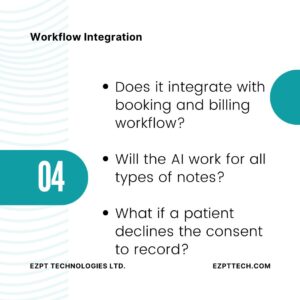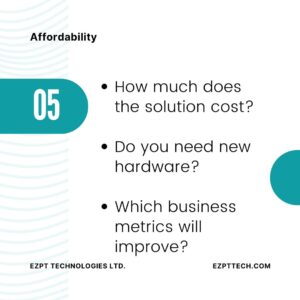Share via:
Introduction
The healthcare industry is at a significant turning point. For decades, clinicians have struggled with Electronic Medical Records (EMRs), but now they have access to a wide array of AI-powered solutions designed to automate their workflow. Among these, documentation stands out as a prime use case due to the stress, frustration, and burnout it causes for physical therapists. The critical question is: should clinicians turn to AI for documentation? The answer is an unequivocal yes. Administrative paperwork is not the best use of skilled clinicians’ time. When selecting a documentation software for your practice, it’s essential to evaluate the solution carefully. Here are a few criteria to help you choose a Physical Therapy documentation software that will meet your practice’s needs and enhance your efficiency.
Key criteria for selecting PT documentation

1. Privacy & Security
One of the most crucial criteria for selecting PT documentation software is ensuring that it meets strict privacy and security standards. This includes:
- HIPAA Compliance: Is the software HIPAA compliant? This is non-negotiable for protecting patient information.
- PHI Encryption: How is Protected Health Information (PHI) encrypted? Strong encryption ensures that patient data is secure.
- PHI Management: What is done with the PHI? Understand how the software handles, stores, and manages sensitive data.

2. Notes Quality
The quality of notes produced by the software is another essential factor. High-quality documentation is critical for both clinical accuracy and compliance with insurance standards.
- Writing Style Match: Do the notes match your writing style? The software should adapt to the clinician’s voice to maintain consistency.
- Detail Level: Do the notes include all required details? Comprehensive documentation is vital for both patient care and meeting regulatory standards.
- Compliance Standards: Do the notes meet insurance and documentation standards? The software should ensure that all documentation aligns with industry requirements.

3. Tech Accuracy
Accuracy is key when it comes to PT documentation software. Inaccurate or incomplete notes can lead to problems down the line.
- Note Accuracy: Are the notes accurate? Accuracy in documentation reflects the quality of care provided.
- Repetitions & Hallucinations: Do the notes contain repetitions or hallucinations? These errors can undermine the credibility of your documentation.
- Editing Needs: How much editing is required? The less time you spend editing, the more efficient your workflow will be.

4. Workflow Integration
Effective integration with your existing systems is essential for seamless operation.
- Booking & Billing Integration: Does the software integrate with booking and billing workflows? This integration is crucial for streamlining administrative tasks.
- Comprehensive Note Coverage: Will the AI work for all types of notes? The software should handle various documentation types without issue.
- Patient Consent: What happens if a patient declines consent to record? The software should have protocols in place for such scenarios.

5. Affordability
Cost is always a factor when selecting software. It’s important to consider both the direct and indirect costs associated with the solution.
- Solution Cost: How much does the software cost? Evaluate whether the price aligns with your budget.
- Hardware Requirements: Do you need new hardware? Consider whether additional investments are required.
- Business Impact: Which business metrics will improve? Look at the potential return on investment in terms of efficiency, productivity, and patient satisfaction.
Additional Considerations
In addition to the core criteria, there are other factors to consider when selecting PT documentation software:
- Customization: Can the software be tailored to your practice’s unique needs? Customization is essential for fitting the software into your workflow.
- User-Friendliness: Is the software easy to learn and use? Both clinicians and administrative staff should find the software intuitive.
- Scalability: Can the software grow with your practice? Scalability ensures that the software can handle increased demands over time.
- Support & Maintenance: Does the vendor offer reliable support and ongoing maintenance? Continuous support is vital for addressing any issues that arise.
Conclusion
Physical Therapy documentation software is evolving rapidly. AI is a powerful tool that can transform clinic operations by automating redundant tasks and alleviating administrative burdens. However, choosing the right PT documentation software is crucial. Selecting the wrong solution can undermine your practice’s goals and lead to frustration.
At ezPT, our goal is to provide physical therapy providers with a solution that not only meets but exceeds their expectations across all criteria. We also aim to educate the market about this innovative technology, empowering clinicians to set higher standards and demand more from their software vendors.
ezPT is available for free. Try it today and learn more about how we can elevate the documentation and compliance standards of your clinic.
What other criteria do you consider when evaluating PT documentation software for your practice? Share your thoughts in the comments.
 Founder & CEO at ezPT
Founder & CEO at ezPT
Share via: